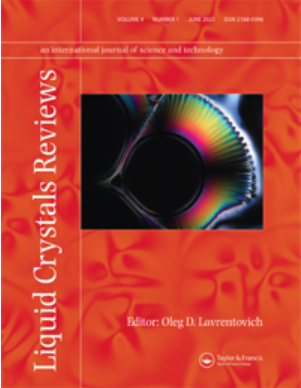Liquid crystals as signal transducers for sensing of analytes using aptamer as a recognition probe
IF 4.2
3区 材料科学
Q2 CHEMISTRY, PHYSICAL
引用次数: 6
Abstract
ABSTRACT The long-range orientational order of liquid crystals (LCs) makes them excellent responsive materials for amplification and transduction of various biochemical events occurring at their interfaces. LC interfaces have been vastly explored for sensing of various macromolecules such as endotoxin, proteins, and disease markers. LC-based sensors possess several advantages over conventional methods in terms of not requiring intensive labour, label-free detection, and low-cost fabrication. However, the first challenge is to ensure the specificity of LC response towards a particular analyte. The second challenge is to design sensing platforms for the detection of small molecule analytes with equal selectivity and sensitivity. In this regard, aptamers have emerged as promising recognition probes due to their high binding affinity towards small molecules, high stability over antibodies, and fast response. The integration of aptamer-based sensing with LC interfaces has enabled the detection of deoxyribonucleic acid (DNA) targets, biologically important toxins, environmental pollutants, heavy metal ions, etc., with applicability in clinical samples. In this review, we recapitulate the recent advancements in the design of aptamer-based LC biosensors for the detection of DNA targets (by DNA hybridization), various biomolecules, and metal ions. GRAPHICAL ABSTRACT液晶作为信号换能器,用适体作为识别探针来检测分析物
摘要液晶(LC)的长程取向顺序使其成为放大和转导界面上发生的各种生物化学事件的优秀响应材料。LC界面已被广泛探索用于传感各种大分子,如内毒素、蛋白质和疾病标志物。与传统方法相比,基于LC的传感器在不需要密集劳动力、无标签检测和低成本制造方面具有几个优势。然而,第一个挑战是确保LC响应对特定分析物的特异性。第二个挑战是设计具有同等选择性和灵敏度的检测小分子分析物的传感平台。在这方面,适体由于其对小分子的高结合亲和力、对抗体的高稳定性和快速反应而成为有前途的识别探针。基于适体的传感与LC接口的集成使脱氧核糖核酸(DNA)靶点、生物重要毒素、环境污染物、重金属离子等的检测成为可能,并在临床样品中具有适用性。在这篇综述中,我们概述了基于适体的LC生物传感器设计的最新进展,用于检测DNA靶标(通过DNA杂交)、各种生物分子和金属离子。图形摘要
本文章由计算机程序翻译,如有差异,请以英文原文为准。
求助全文
约1分钟内获得全文
求助全文
来源期刊

Liquid Crystals Reviews
CHEMISTRY, PHYSICALCRYSTALLOGRAPHY&n-CRYSTALLOGRAPHY
CiteScore
7.60
自引率
5.90%
发文量
8
期刊介绍:
Liquid Crystals Reviews publishes review articles on all aspects of liquid crystal fundamentals and applied science, including experimental and theoretical studies of physical and chemical properties, molecular design and synthesis and engineering of liquid crystal devices. The Journal fosters cross-disciplinary exchange of ideas, encouraging authors to present material at a level accessible to specialists from other fields of science and engineering. Liquid Crystals Reviews provides the scientific community, in both academia and industry, with a publication of standing, guaranteed by the Editors and by the International Editorial Board who are active scientists in the worldwide liquid crystal community.
 求助内容:
求助内容: 应助结果提醒方式:
应助结果提醒方式:


